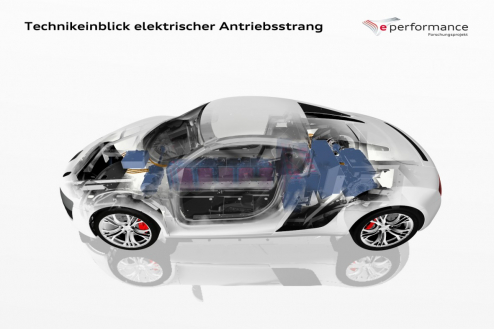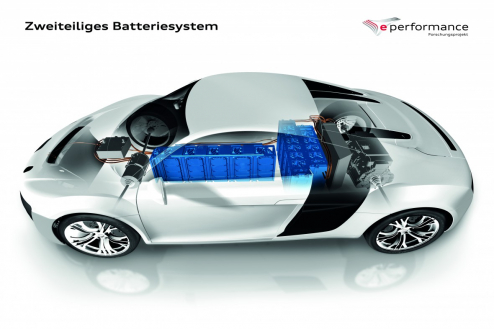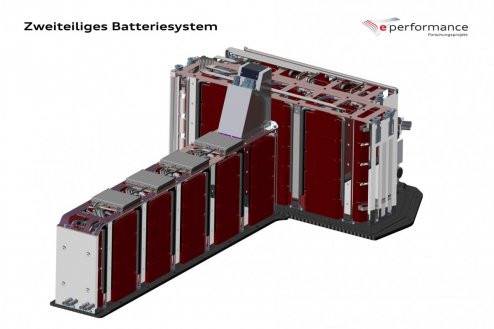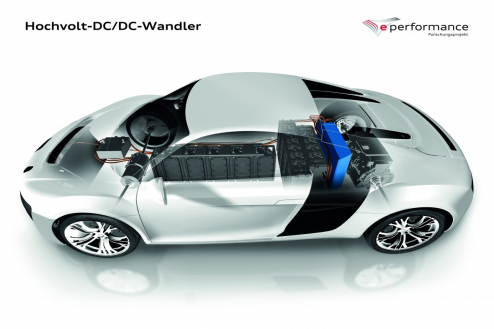e performance research project
Audi is systematically working out all aspects of electric mobility from the ground up. The e performance research project – a think tank within the company – has developed a modular component system for electrically powered vehicles. This has resulted in a sporty research vehicle, the F12, in the framework of a research project sponsored by the German Federal Ministry of Education and Research (BMBF).
In its exterior appearance, the F12 research vehicle resembles the Audi R8 e-tron, which will appear on streets at the end of this year. The high-performance R8 sports car (Combined fuel consumption in l/100 km: 14.9 – 12.4; Combined CO2-emissions in g/km: 349 - 289)** with its lightweight aluminum Audi Space Frame body served as the starting point for both projects. The research vehicle, which weighs around 1,650 kg (3,637.63 lb), also attains sporty performance values. It accelerates from zero to 100 km/h (62.14 mph) in less than seven seconds. Its top speed is electronically limited to 180 km/h (111.85 mph), and its driving range is around 200 km (124.27 miles).
Developers working on the e performance research project took entirely new approaches to the car’s drive technology. They were not concerned with the production maturity of the car, but rather with taking a broad-based and comprehensive approach to its design. Key components of the F12, all custom fabricated parts, can be interchanged with minimal effort to enable many new configurations. The system matrix is scalable – when engineers make suitable modifications to the parts they can also be used to configure a sedan or a city car with an electric or plug-in hybrid drive.
Two large, separately housed battery blocks with a total energy capacity of 38.9 kWh serve as the car’s energy storage devices. The front battery block is longitudinally mounted in the center tunnel that was specially adapted for this purpose, and the rear block is mounted transversely in front of the rear axle. The liquid-cooled batteries weigh around 400 kg (881.85 lb); they consist of a total of 5,200 cylindrical lithium-ion cells of the type commonly used in consumer electronics.
Each set of 26 cells forms a battery module; they are embedded in a poured high-strength structural foam and are protected by aluminum profiles integrated in the package as well. The modules can be shifted next to one another with their diagonally slanted walls. This forms the basis for the safety design which, according to calculations, can withstand a pole side impact. The rear battery is installed in an ultra-lightweight pan made of carbon fiber reinforced polymer (CFRP).
Three electric motors of different types work together to drive the research vehicle. Each rear wheel is coupled to an asynchronous motor via a single-stage gearbox; each motor outputs 50 kW of power and 200 Nm (147.51 lb-ft) of torque. An intelligent control system distributes drive forces based on demand – this “torque vectoring” makes handling even more stable and sporty. A synchronous motor is installed in the front section of the car; it delivers its 50 kW and 150 Nm (110.63 lb-ft) to a newly developed mechanically locking differential via a two-stage gearbox – so the F12 is a fully electric quattro.
The three motors can be driven separately to utilize energy as efficiently as possible. During slow driving, only the synchronous motor is active; it achieves a very high level of efficiency. At higher speeds, the performance-optimized asynchronous motors come into play at the rear axle.
Another innovation in the F12 is the switchable high-voltage electrical system. Following the basic idea of scalability, the two batteries can produce different output voltages at either 148 or 222 volts. A high-performance direct current converter (DC/DC) regulates the desired uniform system voltage. Under part-load, the voltage is around 200 volts to maximize efficiency; with increasing power demand, it can be boosted up to 440 volts.
The advanced development team of the e performance research project targeted a maximum level of integration in designing the control modules. With this goal in mind, they utilized valves similar to those used in building technology for the heat pump that handles thermal management of the drive system and the interior. In many situations, the heat pump is used to heat up the batteries; this heat is stored and is available to heat the interior on the next drive.
The driver of the F12 controls basic drive functions – P, R, N and D – by operating buttons on the center tunnel. An iPad in a mounting bracket on the center console is used to perform all other operating steps, including the degree of energy recovery and settings for the synthetic e-Sound. When the driver arrives at his or her destination, the iPad can be removed and used to configure the car remotely. A user-programmable instrument cluster displays all important information in virtual digital graphics with very high resolution and quality.
The F12 research vehicle was created as part of a three-year research project sponsored by the German Federal Ministry of Education and Research. The project budget was 36 million euros. Engineers from Audi, its subsidiary Audi Electronics Venture GmbH (AEV) and scientists from the ika, ISEA and IEM institutes of the RWTH Aachen university formed the core team of the e performance research project. Other external specialists from the technical universities in Munich, Dresden and Ilmenau, Hanover’s Leibniz University and the Fraunhofer IISB and IESE institutes provided scientific support. Key industrial partners involved in the project were Robert Bosch GmbH and Bosch Engineering GmbH.
The e performance research project has the freedom to explore entirely new approaches. Advanced development tools and a new type of knowledge management helped to create an atmosphere characterized by engineering ingenuity, creativity, open discussions and flexible networking. Cameras document every step in construction, and all findings flowed via a ticket system onto a server that was available to all participants across Germany.
This high level of transparency and networking based on the principle of “open innovation” allowed the research project to have a very positive influence on Germany’s entire higher education system and industry. Partnerships are continuing even after completion of the F12 – the first follow-up projects that focus on special technical issues have already begun. Individual solutions, such as the CFRP housing for the rear battery, show good prospects for later production use.
**Figures depend on the tires/wheels used.
Status: 2012



